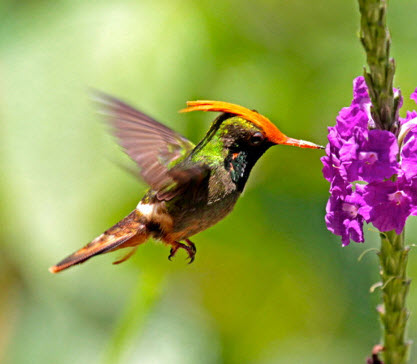Everyday I am amazed as I wake up to hundreds of different kinds of birds that come into our yard here in Panama. I can see why some people make specail trips to places like Panama just to enjoy watching these beautiful creatures.
Birding is more than a mere hobby in my crowd of birding buddies. For us it’s a way of life, offering a window into a fascinating world of beauty, excitement and mystery.
Birding is also the best excuse I know of to travel to exotic places in pursuit of these lovely plumed creatures.
I had the good fortune to spend two weeks recently with three of my best birding buds on an eco-tour to two of Central America’s most spectacular and bountiful birding destinations: Panama and Costa Rica.
The trip was so amazing that I felt compelled to split my report, one for each country.
On what was my first visit to Panama, I was immediately impressed by the cosmopolitan feel to Panama City, the ease of travel and the lush rainforest habitat bordering the Panama Canal, located about a half-hour’s drive from the airport.
We divided our stay between two birding lodges considered among the best in the world: the Canopy Tower and the Canopy Lodge. We occasionally drove past a small prison on the canal where former dictator Manuel Noriega, now 81, has been held since 2011 for murder and other crimes committed during his six years in power.
Led by two of Central America’s top birding guides – Paco Madrigal of Costa Rica and Carlos Bethancourt of Panama – we tallied a total of more than 400 species, including 320 in Panama, and featuring 34 species of hummingbirds, 30 tanagers and 19 North American warblers.
It would be unfair to compare the birds of North America to the nearly 1,000 species that spend time in the birding paradise of Panama and Costa Rica. But it was thrilling to encounter neotropic migrants familiar to Northeast Ohio birders before they departed on the warm Southwest winds of spring for their northern breeding grounds.
From the rooftop observation deck of the Canopy Tower, we enjoyed thousands of migrating raptors traveling northward, passing by in swirling kettles. There were broad-winged, Swainson’s and short-tailed hawks, Mississippi and swallow-tailed kites, osprey and turkey vultures.
The four-story former U.S. Air Force radar tower also offered us eye-level views into the forest canopy, where we spotted colorful North American migrants such as Baltimore orioles, scarlet and summer tanagers, olive-sided and great crested flycatchers, red-eyed vireos, and warblers: golden-winged, black-and-white, Tennessee, bay-breasted, Blackburnian, chestnut-sided and Canada.
Our familiar migrating birds were communing with brilliantly plumaged resident species such as keel-billed toucans, blue cotinga, blue-headed and mealy parrots, rufous-capped warblers, bananaquits, euphonias, and an assortment of tanagers: crimson-backed, flame-rumped, blue-gray, golden-hooded, bay-headed, silver-throated, scarlet-thighed and blue dacnis, plus green and red-legged honeycreepers.
Adding to the excitement were troops of howler monkeys, snakes, lizards, the occasional two-toed and three-toed sloths, brightly hued butterflies, and roving swarms of leaf-cutter and army ants.
Then there were the odd and exotic species so foreign to North American birders. For instance, in Northeast Ohio we have one species of hummingbird: the ruby-throated. In Panama, we marveled at an array of shapes, colors and sizes from dozens of species that included white-necked Jacobin, stripe-throated and long-billed hermits, garden emerald, violet-headed and violet-bellied, blue-chested, snowy-bellied, and crowned woodnymph.
We were dazzled by sightings of species such as motmots, trogons, puffbirds, barbets, woodcreepers, caciques, oropendolas, and antbirds: antshrikes, antvireos, antwrens, antthrush and antpittas.
Anyone who remembers Michael Jackson’s moonwalking steps would recognize the source of this iconic move: manakins, which are tiny and colorful forest birds that perform elaborate mating dances while popping their wings on forest stages known as leks. We discovered five species of manakins in Panama, including priceless views of red-capped, golden-collared and blue-crowned.
